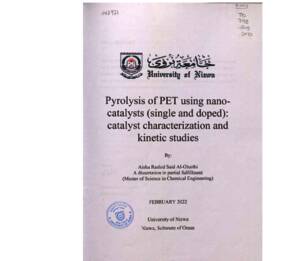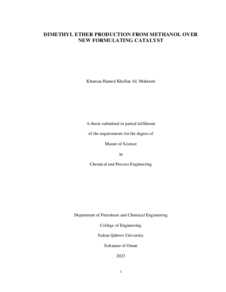Document
Pyrolysis of PET using nano-catalysts (single and doped) : catalyst characterization and kinetic studies.
Source
Master 's thesis
Country
Oman
City
Nizwa
Publisher
University of Nizwa
Gregorian
2022
Language
English
Subject
Thesis Type
Master 's thesis
English abstract
Recently, quick rise of population and development in lifestyle has caused an increase in waste production. Therefore, recycling is an essential process to control waste effectively. Research interest in the conversion of polyethylene terephthalate (PET) waste into useful energy via pyrolysis process has increased extensively. To optimize the pyrolized nanocatalyst and operating conditions, an understanding of the pyrolysis kinetics of PET is of fundamental importance. This study investigated the pyrolysis kinetics of PET waste in three cases (no catalyst, NiO, and V2Os) under different heating rates.
In the present study, PET with different nanocatalyst were pyrolyzed using thermogravimetric analysis under the nitrogen flow. The sample was heated up to 600°C in the non-isothermal degradation process with ramp of 5°C/min, 10°C/min, 15°C/min, and 20°C/min. A created nano catalyst, NiO, V205 with different structures and doped of the two metal oxides together, were used via mixing them with grinded PET at certain loading ratios to investigate the nanocatalyst performance on PET decomposition in terms of activation energy, ash remaining weight percent. NiO and V205-nanoparticles were chemically formed using sol-gel methodology and both types were calcinated using different environments furnace, or microwave and non-thermal plasma. Hydrogen reduction was also used on those catalysts to eradicate on oxygen atoms from the metal oxide and to study their effects on the pyrolysis outcomes. SEM, EDS, TEM, and XRD techniques were implemented to investigate the successful preparation of NiO-NPs and V205 -NPs. Calcination step using the microwave was completed within 30 min and produced NPs was cubical shape with size range of 5-70 nm and in comparison with ordinary furnace, which needed three hours to give similar results. Those NPs, from the microwave, gave the best results among the single metal oxide NPs used whereby Ea, remaining ash percent were recorded to be the lowest and maximum derivative weight to be the highest. A series of tests was conducted with TGA to obtain data critical to determining the nanocatalyst's various properties (Time, Temperature, Weight loss %, Heat flow %, and derivatives weight %).
The Optimum sample among the tested catalyst is the reduced Ni in term of activation energy with 170.7 kJ/mol. In contrast, Vanadium doped Nickel reduction is the best catalyst if the remaining weight percent (0.12%) is concerned point. Maximum derivative weight percent analogy, Ni doped V reduction is recorded as preferable where it reaches up to 20% indicating the highest conversion percent this sample reaching.
Keywords: Pyrolysis; Nanocatalyst; Polyethylene Terephthalate (PET); Sol-gel preparation; doped catalyst; Kinetics.
Category
Theses and Dissertations


